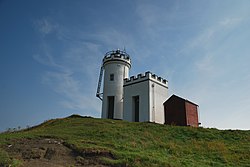Elie
| Earlsferry | |
| Fife | |
|---|---|
 Elie Lighthouse | |
| Location | |
| Grid reference: | NO493000 |
| Location: | 56°11’24"N, 2°49’5"W |
| Data | |
| Population: | 940 (2004 est.) |
| Post town: | Leven |
| Postcode: | KY9 |
| Dialling code: | 01333 |
| Local Government | |
| Council: | Fife |
| Parliamentary constituency: |
North East Fife |
Elie is a village on the coast of Fife, within the East Neuk, along the north shore of the Firth of Forth. The older village of Earlsferry stands beside it to the west; the two have run into each other long since and were together constituted a burgh in the twentieth century.
A broad beach joins Elie to Earlsferry to seaward, the headlands guarding the beach being Elie Ness to eastward and Chapel Ness at Earlsferry on the west.
History
Earlsferry is an old village first settled in time immemorial. Little is known of the foundation of Elie, but it had become sufficiently important to merit the building of Elie Parish Church in 1639. Its harbour was more sheltered than that of Earlsferry and it began to poach trade away from Earlsferry..
The Reformation ended pilgrimages to neighbouring Earlsferry, so that few ships now entered that harbour. Then in 1766 a severe storm choked Earlsferry's harbour with sand and the remaining trade moved to Elie.
In the 1770s the Lady's Tower was built in Ruby Bay, on the east side of Elie Ness, as a changing room for the Lady Anstruther. It is said that Lady Anstruther would bathe in the waters next to Lady's Tower, a servant ringing a bell all the while to ensure locals stayed away.[1]
Elie and Earlsferry have run into each other so that one may hardly know where one finishes and the other begins. The modern villages now largely share shops and other facilities, but they do retain a flavour of their historical identities.
In recent decades, the villages have become a popular destination for wealthy residents of Glasgow and Edinburgh. In the summer months the town's population is several times higher than it is during the winter. Attractions include the beach, golf, restaurants, surfing and sailing.
The railway line fell under the Beeching Axe in the 1960s and the station and tracks were subsequently closed and dismantled, leaving Elie with only road and sea transport links.
Buildings
Elie has an unusual parish church with a tall hexagonal tower, topped with a belvedere detail, centrally located on the church. It is approached on axis from the High Street, increasing the drama of its architecture, and surrounded by a churchyard burial ground.
On the outer corner of the churchyard wall, where the main road makes a right angle, stands the village war memorial. This is of particularly poignant composition, as each name listed also states their trade before the war and their battalion number and regiment. This therefore highlights a number of "ploughmen" and a high ratio of "chauffeurs". It may be speculated that the latter were in service on the several large country estates encircling the village.
Elie Castle is an interesting Scots vernacular extended tower house, standing close to the waterline. Superficially it dates largely from the early 17th century but contains older elements possibly from the 15th century. The High Street nearby contains several good 17th century houses with curious doorpieces.
Trivia
The film The Winter Guest, starring Emma Thompson and Phyllida Law, directed by Alan Rickman, was filmed around the villages.
The famous Floral clock in Edinburgh's Princes Street Gardens was originally constructed (1903) using the clock mechanism salvaged from Elie Parish Church.[2]
Outside links
| ("Wikimedia Commons" has material about Elie) |
References
- ↑ Mackintyre, Lorn (2008). Portrait of the East Neuk. Alvie. p. 124. ISBN 9780951180051.
- ↑ Monuments and Statues of Edinburgh, Michael T.R.B. Turnbull (Chambers) p.5